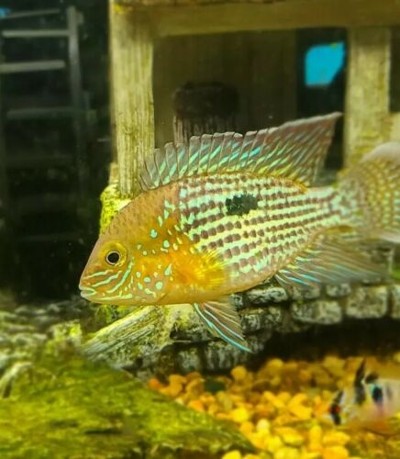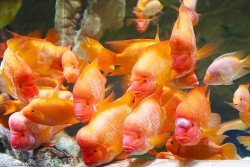Aequidens rivulatus suitable tank mates
 Green terror cichlids are known labeled as Andinoacara rivulatus but they previously were known as Aequidens rivulatus for quiet sometime. These South American cichlids are very brightly colored with fluorescent bright blue scales. There are other species in this genus which can be perceived to be Green terrors but their different but similarly looking cichlids. They include Andinoacara stalsbergi and Andinoacara sp. Gold/Silver saum. Some of the confusion is around the color of their fins along the dorsal and caudal. Some are colored white and others reddish orange color. The ultimate feeding guide for Andinoacara rivulatus of South America.
Green terror cichlids are known labeled as Andinoacara rivulatus but they previously were known as Aequidens rivulatus for quiet sometime. These South American cichlids are very brightly colored with fluorescent bright blue scales. There are other species in this genus which can be perceived to be Green terrors but their different but similarly looking cichlids. They include Andinoacara stalsbergi and Andinoacara sp. Gold/Silver saum. Some of the confusion is around the color of their fins along the dorsal and caudal. Some are colored white and others reddish orange color. The ultimate feeding guide for Andinoacara rivulatus of South America.The beauty and natural aggressiveness of Andinoacara rivulatus makes them ideal for hobbyists who wish to add variety to their cichlid aquarium. There is a reason their called Green terrors! A. rivulatus can be kept with other big cichlids like A. ocellatus or Oscar cichlids, R. octofasciata known as Jack Dempsey cichlids, A. citrinellus the Midas cichlid sometimes called the Red Devil, T. meeki known as the Firemouth cichlid, P. managuense the Jaquar cichlid, and other similarly aggressive cichlids but not limited to cichlids. Example you can keep them with Arowana, or Datnoides. It’s just a matter of balancing the community with the right mix of fish.
As is standard with most large cichlids, the Green Terror is aggressive and requires a large aquarium or community tank. When young they can readily be kept in a community tank with other South American cichlids, but as they mature the will become pugnacious and should be separated into their own tank or into a tank with comparable sized cichlids that match their temperament. It’s not uncommon to give them at least 30 to 40 gallons of space just for themselves when kept as a single fish. As a pair they will benefit from 55 gallons or more.

Aequidens rivulatus extended list of tank mates
Aequidens rivulatus, commonly known as the Green Terror cichlid, is a beautiful but sometimes aggressive cichlid species native to South America. When selecting tank mates for Green Terrors, it's essential to consider their territorial and occasionally aggressive behavior. Here are some suitable tank mates to consider:
1. Other Large Cichlid Species: Pairing Green Terrors with other large and robust cichlid species from South America can work well. Fish like the Midas cichlids, Jack Dempsey cichlids or the Severum can handle the occasional aggression and territorial disputes.
2. Geophagus Species: Geophagus cichlids, such as Geophagus steindachneri or Geophagus jurupari, are peaceful in nature and can coexist with Green Terrors. They are also from South America and share similar water parameters.
3. Large Characins: Large characin species like Silver Dollars or large Tetras can be suitable tank mates as long as they are of similar size. These fish are usually fast swimmers and can avoid confrontations.
4. Plecostomus and Catfish: Peaceful and bottom-dwelling catfish like Plecos (e.g., Bristlenose Plecos) or large Corydoras catfish can be good companions. They occupy different areas of the tank and are less likely to compete for territory.
5. Acara Species: Some Acara cichlid species, such as the Blue Acara (Andinoacara pulcher), can coexist with Green Terrors, provided you have a sufficiently large tank with plenty of hiding spots.
6. Rainbowfish: Some larger species of Rainbowfish, like the Boeseman's Rainbowfish or the Madagascar Rainbowfish, can make good tank mates as they are peaceful and typically occupy different areas of the tank.
7. Large, Peaceful Gouramis: Some large Gourami species, like the Giant Gourami, can be compatible with Green Terrors. Ensure that the tank is spacious enough to prevent territorial disputes.
8. Keeping a Mated Pair: If you have a mated pair of Green Terrors, they may be less aggressive when raising their fry. However, monitor their behavior closely, as they can still become territorial during breeding.
Keep in mind that individual fish may have varying temperaments, so it's crucial to observe their interactions closely when introducing new tank mates. Always have a backup plan to separate fish if aggression becomes a significant issue. Additionally, providing plenty of hiding spots, caves, and visual barriers in the aquarium can help reduce territorial disputes and aggression among tank mates.
South American Fish Peru Cichlid Green Terror
References
Green terror - Wikipedia, the free encyclopediaTips on Keeping Aequidens rivulatus aka The Green Terror






